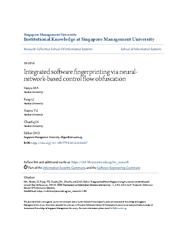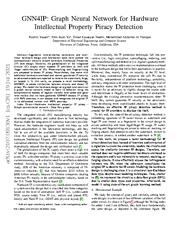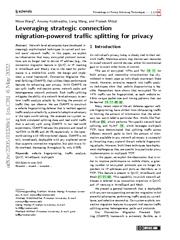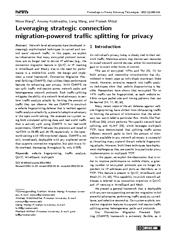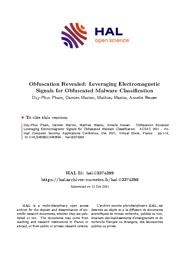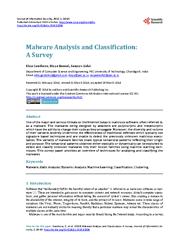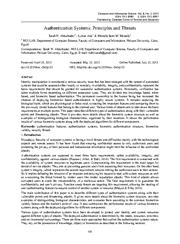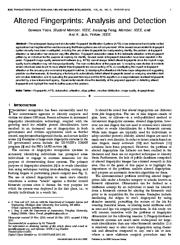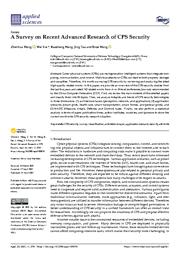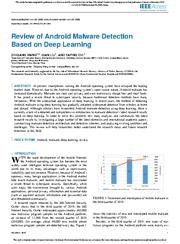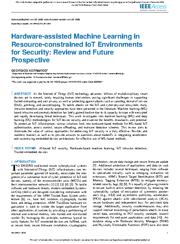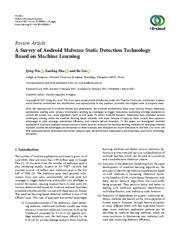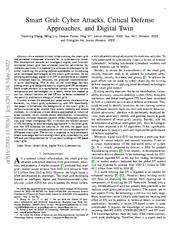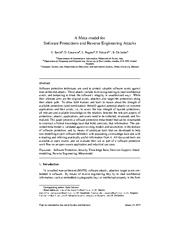A copy of this work was available on the public web and has been preserved in the Wayback Machine. The capture dates from 2020; you can also visit the original URL.
The file type is application/pdf.
Filters
Integrated Software Fingerprinting via Neural-Network-Based Control Flow Obfuscation
2016
IEEE Transactions on Information Forensics and Security
We then provide the first implementation of integrated fingerprinting called Neuroprint on top of a control flow obfuscator that replaces program's conditional structures with neural networks trained to ...
Leveraging the rich entropy in the outputs of these neural networks, Neuroprint embeds software fingerprints such that a one-time construction of the networks serves both purposes of obfuscation and fingerprinting ...
To take one step further, we propose the first realization of integrated fingerprinting -named Neuroprint -on top of a previously proposed neural-network-based software control flow obfuscation approach ...
doi:10.1109/tifs.2016.2555287
fatcat:lweugzs5pzhltpf3dfi42hzm4e
GNN4IP: Graph Neural Network for Hardware Intellectual Property Piracy Detection
[article]
2021
arXiv
pre-print
We model the hardware design as a graph and construct a graph neural network model to learn its behavior using the comprehensive dataset of register transfer level codes and gate-level netlists that we ...
Watermarking and fingerprinting are proposed to detect IP piracy. ...
Our architecture is inspired by the Spatial-based Graph Convolution Neural Network, which defines the convolution operation based on a node's spatial relations with the following phases: (i) message propagation ...
arXiv:2107.09130v1
fatcat:hmtwnfb3urflreowc7hbvgnjiy
Leveraging strategic connection migration-powered traffic splitting for privacy
[article]
2022
arXiv
pre-print
Network-level adversaries have developed increasingly sophisticated techniques to surveil and control users' network traffic. ...
With CoMPS, we can split traffic mid-session across network paths and heterogeneous network protocols. ...
Since TLS is integrated into QUIC, QUIC connections will also be susceptible to SNI-based censorship [21] . ...
arXiv:2205.03326v1
fatcat:6qcx4wrnvvc5rcoft3bqlekvua
Leveraging strategic connection migration-powered traffic splitting for privacy
2022
Proceedings on Privacy Enhancing Technologies
Network-level adversaries have developed increasingly sophisticated techniques to surveil and control users' network traffic. ...
With CoMPS, we can split traffic mid-session across network paths and heterogeneous network protocols. ...
Since TLS is integrated into QUIC, QUIC connections will also be susceptible to SNI-based censorship [21] . ...
doi:10.56553/popets-2022-0083
fatcat:jtihclzbobcirdomoefetsnciu
Obfuscation Revealed: Leveraging Electromagnetic Signals for Obfuscated Malware Classification
2021
Annual Computer Security Applications Conference
Even more, our results show that we are able to classify altered malware samples with unseen obfuscation techniques during the training phase, and to determine what kind of obfuscations were applied to ...
Using our approach, a malware analyst is able to obtain precise knowledge about malware type and identity, even in the presence of obfuscation techniques which may prevent static or symbolic binary analysis ...
By integrating obfuscation techniques against software-based malware analysis systems, we are able to determine if these techniques also hinder analysis based on EM emanation, and if we can distinguish ...
doi:10.1145/3485832.3485894
fatcat:tqzl6tvwffdvxftflyzzdcyp3u
Malware Analysis and Classification: A Survey
2014
Journal of Information Security
Malware authors use obfuscation techniques [6] like dead code insertion, register reassignment, subroutine reordering, instruction substitution, code transposition, and code integration to evade detection ...
One of the major and serious threats on the Internet today is malicious software, often referred to as a malware. ...
authors would like to thank Government of India, Ministry of Communications and Information Technology, Department of Information Technology, New Delhi, for funding the Project "Development of Cloud Based ...
doi:10.4236/jis.2014.52006
fatcat:3tr7xtplorg7bjnuv6cv43wxc4
Authentication systems: principles and threats
2015
Computer and Information Science
They are divided into knowledge based, token based, and biometric based authentication. ...
Availability, integrity, and confidentiality represent the basic requirements that should be granted for successful authentication systems. ...
Fingerprint obfuscation and impersonation are examples of presentation threats that attack the fingerprint authentication system at the sensor level. ...
doi:10.5539/cis.v8n3p155
fatcat:q2zk47molbbpvhxgw6k3lifh6y
Altered Fingerprints: Analysis and Detection
2012
IEEE Transactions on Pattern Analysis and Machine Intelligence
Several cases of fingerprint obfuscation have been reported in the press. ...
Fingerprint image quality assessment software (e.g., NFIQ) cannot always detect altered fingerprints since the implicit image quality due to alteration may not change significantly. ...
The authors would like to thank John Manzo of the FBI and Laura Tierney and Arun Vemury of the DHS for providing access to the altered fingerprint images. ...
doi:10.1109/tpami.2011.161
pmid:21808092
fatcat:ft43p73ejjgyte62ijwkwxferq
A Survey on Recent Advanced Research of CPS Security
2021
Applied Sciences
Cyber-physical systems (CPSs) are next-generation intelligent systems that integrate computing, communication, and control. Malicious attacks on CPSs can lead to both property damage and casualties. ...
, smart transportation, smart homes, and general grids); and (3) MADC (Measure, Attack, Defense, and Control) types. ...
Gemini [142] is a neural network-based method for detecting the similarity of firmware. ...
doi:10.3390/app11093751
fatcat:fxby2wjzpnchrfshvilxalmptm
Review of Android Malware Detection Based on Deep Learning
2020
IEEE Access
Although scholars have researched Android malware detection using deep learning, there is currently a lack of a detailed and comprehensive introduction to malware detection's latest research results based ...
ACKNOWLEDGMENT This research was financially supported by the Key Lab of Information Network Security, Ministry of Public Security (C19614), the Fundamental Research Funds for the Central Universities( ...
They propose an anti-obfuscation classification method for Android malicious applications integrating Recurrent Neural Network and Convolutional Neural Network, with antiobfuscation ability and lightness ...
doi:10.1109/access.2020.3028370
fatcat:tujn3ghssrfkffzafat7l3cnse
Hardware-assisted Machine Learning in Resource-constrained IoT Environments for Security: Review and Future Prospective
2022
IEEE Access
To protect an IoT infrastructure, various solutions look into hardware-based methods for ML-based IoT authentication, access control, secure offloading, and malware detection schemes. ...
review aims to illuminate the value of various approaches for addressing IoT security in a truly effective, flexible, and seamless manner, as well as to provide answers to questions about tradeoffs in integrating ...
attacks) [103] , designers' trend involves control flow integrity (CFI) checking. ...
doi:10.1109/access.2022.3179047
fatcat:damwrncpzzbxzamtghwlmrg6v4
A Survey of Android Malware Static Detection Technology Based on Machine Learning
2021
Mobile Information Systems
Malicious applications stealing users' privacy information, sending text messages to trigger deductions, exploiting privilege escalation to control the system, etc., cause significant harm to end users ...
To detect Android malware, researchers have proposed various techniques, among which the machine learning-based methods with static features of apps as input vectors have apparent advantages in code coverage ...
Control Flow Graph and Data Flow Graph Features. ...
doi:10.1155/2021/8896013
doaj:9dc548d197fd404fbcd4ee962f374bde
fatcat:mbuavifbmzfmjm3shzm4wcbm4a
Table of contents
2017
2017 IEEE International Symposium on Circuits and Systems (ISCAS)
Software Defined Radio Implementations on Xilinx Zynq FPGA
S-66 -An Adaptive and Low-Complexity All-Zero Block Detection for HEVC Encoder
S-67 -A Convolutional Neural Network Approach for Half-Pel ...
Methods for ASIC Designs Hardware-Based Anti-Counterfeiting Techniques for Safeguarding Supply Chain Integrity Revisit Sequential Logic Obfuscation: Attacks and Defenses TECHNICAL SESSIONS -TUESDAY, MAY ...
doi:10.1109/iscas.2017.8049750
fatcat:csazlovzq5g4bmzlf7uss65sy4
Smart Grid: Cyber Attacks, Critical Defense Approaches, and Digital Twin
[article]
2022
arXiv
pre-print
In the end, the paper puts forward our security considerations on the future development of DT-based smart grid. ...
The survey is expected to help developers break knowledge barriers among smart grid, cybersecurity, and DT, and provide guidelines for future security design of DT-based smart grid. ...
proposed Deep Vulnerability Identification via Graph Neural Networks (Devign) to identify the existence of vulnerabilities in source code functions. ...
arXiv:2205.11783v1
fatcat:fz43u2e6g5gyfepqz44tezelba
A meta-model for software protections and reverse engineering attacks
2019
Journal of Systems and Software
They also use reverse engineering techniques as a preparatory step towards tampering with the software to break its integrity, e.g., to break license checks. ...
All discussed tools are available as open source, and we evaluate their use as part of a software protection work flow on an open source application and industrial use cases. of algorithms [1] . ...
For instance, the control flow flattening obfuscation technique is represented as a Protection class instance [24] . ...
doi:10.1016/j.jss.2018.12.025
fatcat:4v5vctri6re5ha7mtjdpzj3xoa
« Previous
Showing results 1 — 15 out of 415 results

